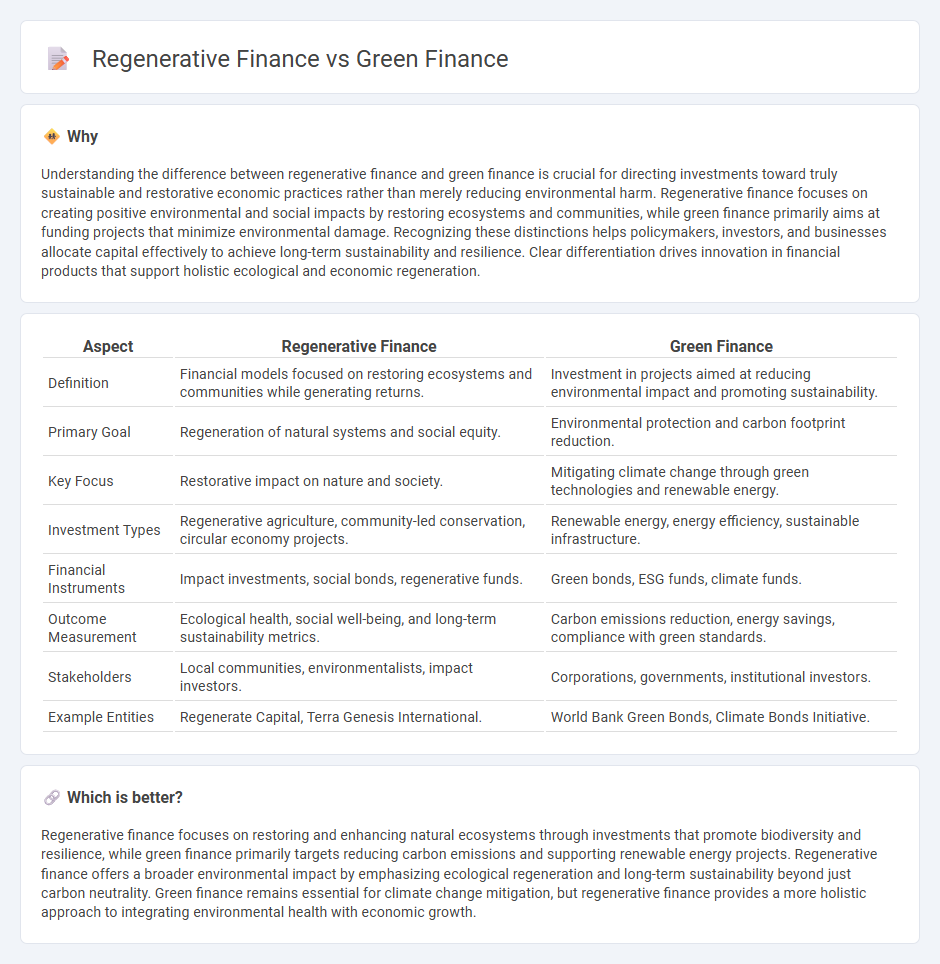
Regenerative finance focuses on restoring ecosystems and communities by investing in projects that promote long-term environmental and social health, while green finance primarily targets reducing carbon emissions and supporting renewable energy initiatives. Both approaches aim to address climate change but differ in their emphasis on sustainability and community resilience. Explore the key differences and benefits of regenerative finance versus green finance to understand their impact on sustainable development.
Why it is important
Understanding the difference between regenerative finance and green finance is crucial for directing investments toward truly sustainable and restorative economic practices rather than merely reducing environmental harm. Regenerative finance focuses on creating positive environmental and social impacts by restoring ecosystems and communities, while green finance primarily aims at funding projects that minimize environmental damage. Recognizing these distinctions helps policymakers, investors, and businesses allocate capital effectively to achieve long-term sustainability and resilience. Clear differentiation drives innovation in financial products that support holistic ecological and economic regeneration.
Comparison Table
| Aspect | Regenerative Finance | Green Finance |
|---|---|---|
| Definition | Financial models focused on restoring ecosystems and communities while generating returns. | Investment in projects aimed at reducing environmental impact and promoting sustainability. |
| Primary Goal | Regeneration of natural systems and social equity. | Environmental protection and carbon footprint reduction. |
| Key Focus | Restorative impact on nature and society. | Mitigating climate change through green technologies and renewable energy. |
| Investment Types | Regenerative agriculture, community-led conservation, circular economy projects. | Renewable energy, energy efficiency, sustainable infrastructure. |
| Financial Instruments | Impact investments, social bonds, regenerative funds. | Green bonds, ESG funds, climate funds. |
| Outcome Measurement | Ecological health, social well-being, and long-term sustainability metrics. | Carbon emissions reduction, energy savings, compliance with green standards. |
| Stakeholders | Local communities, environmentalists, impact investors. | Corporations, governments, institutional investors. |
| Example Entities | Regenerate Capital, Terra Genesis International. | World Bank Green Bonds, Climate Bonds Initiative. |
Which is better?
Regenerative finance focuses on restoring and enhancing natural ecosystems through investments that promote biodiversity and resilience, while green finance primarily targets reducing carbon emissions and supporting renewable energy projects. Regenerative finance offers a broader environmental impact by emphasizing ecological regeneration and long-term sustainability beyond just carbon neutrality. Green finance remains essential for climate change mitigation, but regenerative finance provides a more holistic approach to integrating environmental health with economic growth.
Connection
Regenerative finance and green finance both aim to support sustainable economic development by integrating environmental considerations into investment decisions. Regenerative finance focuses on restoring and enhancing natural ecosystems while generating positive social impact, whereas green finance primarily targets funding projects that reduce environmental risks and promote renewable energy. Together, they drive capital towards initiatives that not only minimize environmental harm but also actively contribute to ecological regeneration and long-term climate resilience.
Key Terms
Sustainable Investing (Green Finance)
Green finance channels capital toward projects that reduce environmental impact, emphasizing renewable energy, pollution control, and sustainable resource management. Regenerative finance extends beyond sustainability by actively restoring ecosystems and enhancing biodiversity through innovative investment models that generate positive environmental and social returns. Explore how these financial approaches shape the future of sustainable investing and create lasting ecological benefits.
Regenerative Capital (Regenerative Finance)
Regenerative finance, exemplified by Regenerative Capital, emphasizes investments that restore ecological systems and enhance social equity, moving beyond the sustainability goals typical of green finance. This approach integrates circular economy principles, supports biodiversity, and prioritizes long-term community resilience to create restorative economic value. Explore Regenerative Capital's innovative strategies for transforming finance to actively heal the planet and society.
Impact Measurement
Green finance emphasizes funding projects that reduce environmental harm, primarily targeting carbon footprint reduction and compliance with sustainability standards. Regenerative finance goes beyond mitigation by actively restoring ecosystems and enhancing social equity through innovative impact measurement tools, integrating social, ecological, and economic indicators. Explore how these approaches transform impact measurement frameworks and drive systemic change in sustainable investing.
Source and External Links
What is green finance and why is it important? - Green finance involves structured financial activities, such as loans and investments, aimed at achieving better environmental outcomes, including funding renewable energy and sustainable projects globally.
Green Finance and Investment - Green finance supports economic growth that reduces pollution and greenhouse gas emissions by mobilizing both public and private investment to transition to a low-carbon and resource-efficient economy.
Green Finance - The IFC promotes green finance through issuing green bonds and supporting private sector climate-smart investments, especially in emerging markets, to unlock funding for renewable energy and energy efficiency projects.
 dowidth.com
dowidth.com